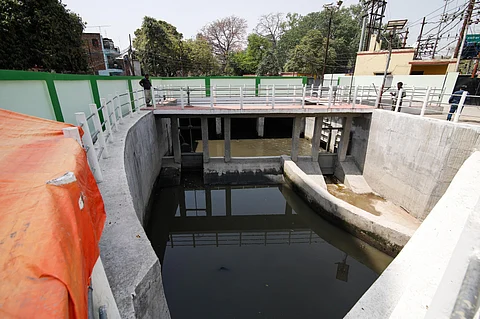

Indian states are falling short of the 70-mark in environmental performance, according to State of India’s Environment 2025 in Figures, the latest data-driven assessment by Down To Earth (DTE) magazine and Delhi-based think tank Centre for Science and Environment (CSE). A major reason: The significant gap between sewage generated and sewage treated.
Even Andhra Pradesh, the highest-ranked state under the “environment” theme in this year’s State of States rankings, managed only 68.38 out of 100. While it scored well on forest and biodiversity and climate indicators, its performance was dragged down by shortcomings in sewage treatment and persistent river pollution.
“This shows that even high-performing states face serious environmental challenges. Progress must be holistic — not selective,” the report noted.
The State of States rankings assess state-level performance across four themes — environment, agriculture & land, public health and human development & public infrastructure — each comprising four sub-categories. The environment theme includes forest and biodiversity, climate, waste management and water. Waste management encompasses sewage treatment, a critical parameter where most states, including Andhra Pradesh, falter.
Andhra Pradesh ranks 18th among 36 states and Union Territories in sewage treatment. The state treates less than 11 per cent of its daily sewage, according to the most recent state-level data from the National Inventory of Sewage Treatment Plants, published by the Central Pollution Control Board.
It is one of 19 states and UTs that scored below 50 on this key indicator, underscoring a nationwide shortfall in sewage infrastructure and treatment capacity.
River pollution is another pressing concern. Andhra Pradesh has reduced the number of polluted river stretches from five in 2018 to three in 2022 (Gostani, Upputeru and Vasishta) but the latter remains critically polluted. The biochemical oxygen demand (BOD) level in the Vasishta river near Narasapuram stood at 58 milligrammes per litre (mg/L), nearly 19 times the safe limit of 3 mg/L for outdoor bathing.
Nationally, the picture is equally alarming. Under the water theme, 27 states and UTs scored below 50. In Karnataka, 41 locations across 17 rivers failed to meet the prescribed BOD criteria for water quality. The most polluted rivers included the Arkavathi, Dakshina Pinakini and Thenpennai. At Mugalur, the Dakshina Pinakini recorded a BOD level of 111 mg/L, which is 37 times above the acceptable limit.
These findings signal that while some environmental indicators are improving, serious gaps in sewage treatment and river health continue to undermine progress and require urgent policy attention.
However, addressing these challenges is hampered by data deficits. In her foreword to the report, DTE Editor and CSE Director General Sunita Narain warned that data gaps will affect planning and action to address these challenges.
She emphasised that effective planning requires solid data to understand what needs to be done — otherwise, we risk getting the plan wrong and pouring the money down the drain. “Take the not-so-simple matter of cleaning our rivers. This programme is based on the volume of wastewater generated, which must be treated before being discharged. But estimates of wastewater are derived from population figures — and without a recent census, this number is at best a projection or worse, a guesstimate. All this then puts into question the plan for river cleaning and how it will work,” Narain stated
India has not conducted a population census since 2011. On June 4, 2025, the Government of India announced that the next census will be conducted in two phases and completed by March 1, 2027.
For detailed, data-backed insights into India’s environmental performance, access the full State of India’s Environment 2025 In Figures report here.